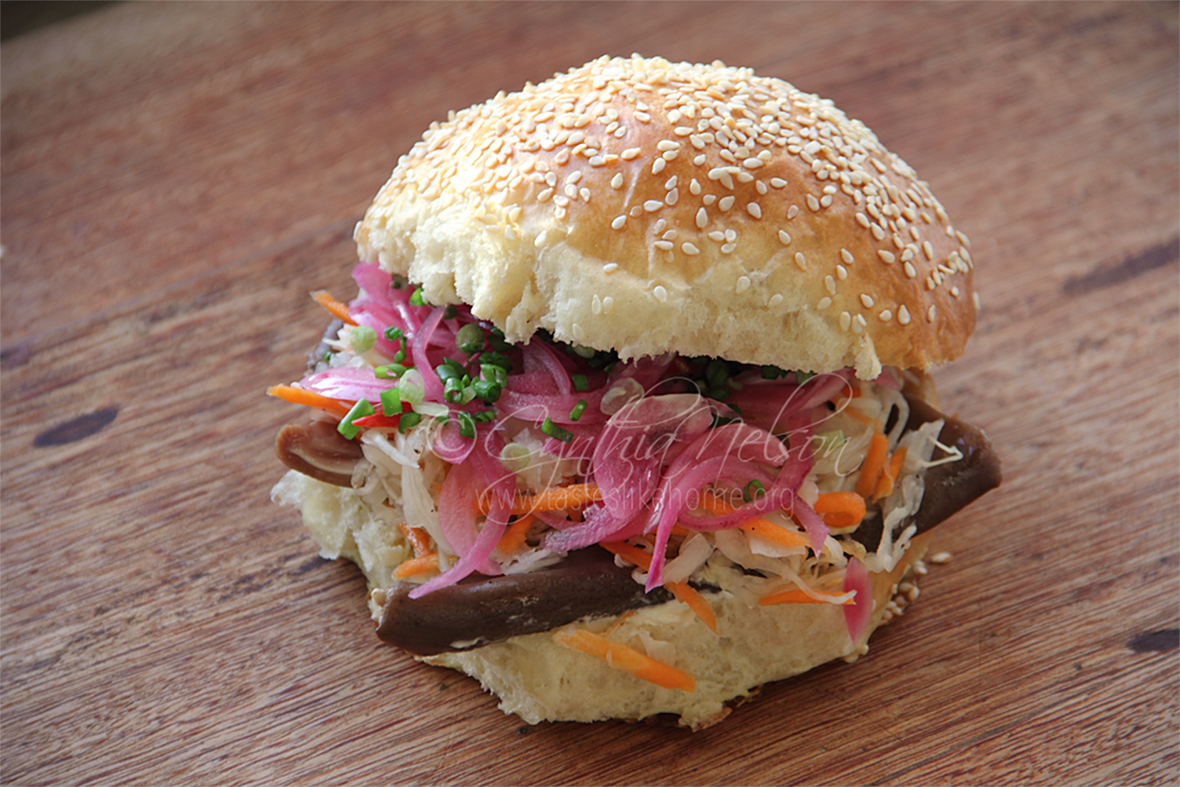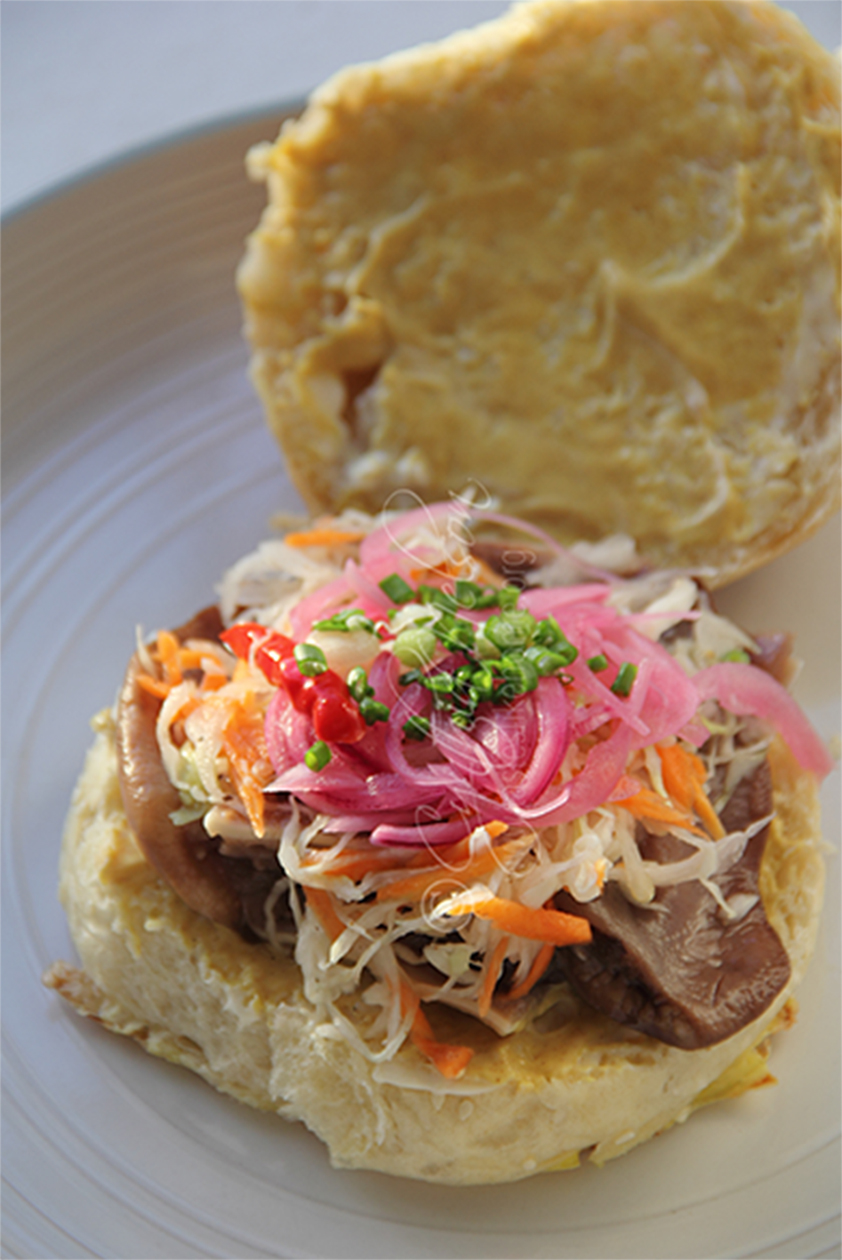 If you like your Pepperpot with cowheel and trotters (pig feet), then you should like this sandwich – it is made with one of the parts of the animal considered to be an odd bit. If you eat souse made of chicken feet, pig ears, snout, cow face, as well as cowheel and pig feet, then, yeah, you should like this sandwich. As with the eating of most offal and odd bits of any animal, it is always a texture thing. Depending on how they are prepared, they can be meltingly soft, tender, chewy, gelatinous or even crispy – Crispy Pig’s Ear Salad anyone?
If you like your Pepperpot with cowheel and trotters (pig feet), then you should like this sandwich – it is made with one of the parts of the animal considered to be an odd bit. If you eat souse made of chicken feet, pig ears, snout, cow face, as well as cowheel and pig feet, then, yeah, you should like this sandwich. As with the eating of most offal and odd bits of any animal, it is always a texture thing. Depending on how they are prepared, they can be meltingly soft, tender, chewy, gelatinous or even crispy – Crispy Pig’s Ear Salad anyone?
I came across an article late last year on the BBC about Pig Ear Sandwich: An Iconic Dish of the American South, and immediately added it to one of my many lists of things to make/things to try. Last week, ahead of the holiday weekend, I went to the butcher to get some beef to make Cook-up Rice, saw she had fresh pigs’ ears and decided to get a few to try making pig ear sandwich.

A quote in the article from a longtime customer of The Big Apple Inn, a soul food joint in the Farish Street neighbourhood of Jackson, Mississippi sums up all you need to know about the role of odd bits in the lives of many in the days of old. “All the unwanted bits of the pig – the feet, the tail, the chitterlings (intestines) and the ears – back in the day, it was what the slave owners used to give to the enslaved for their weekly rations. It’s a wonderful thing that what was once about struggle and survival has been turned over time into a thing of comfort. Soul food. It’s simple, but it’s delicious.”
We in the Caribbean, and as a matter of fact, all over the world where people were enslaved and oppressed, have similar stories and sentiments about a variety ingredients and dishes that we eat today.
Making the sandwich is easy, the “hardest” part is cooking the ears until softened but if you have a pressure cooker, well all you need is about 10 minutes, if that long. The sandwich can be served on a bread-bun roll or thick slices of white bread; coleslaw, mustard and hot sauce are the traditional accompaniments.
Here’s how I made my sandwich.
The ears were rinsed in a bath of fresh lime juice and water, then fresh water and drained well. In a pressure they were cooked until tender with water, a couple of bay leaves, whole black peppercorns, a quartered onion and salt to taste.
I made sesame buns as the bread for the sandwich. Instead of regular coleslaw, I made a quick version of Haitian Pikliz – a spicy briny pickle of carrots and cabbage and hot peppers. I also made some pickled red onions. Mustard and pepper sauce are always on hand.
Cutting the large, cooked ears to fit the bun, I set about assembling my sandwich – I lightly buttered the insides of the cut sesame bun with mayonnaise followed by Dijon mustard, the cooked pig ears, a few drops of pepper sauce and then topped off with some Pikliz, red onions and a sprinkling of scallions. The other half of the bun covered the sandwich like a dome and then it was time to taste, to eat, my pig ear sandwich.
The pig ears were soft and glutinous and as I bit into it, I was greeted by the crunchy cartilage, both textures contrasted well with the bite and heat of the veggies. The pickled red onions were briny and delicious, and the soft bun cooled everything down nicely because there was a lot going on in the sandwich. The bottom line is that it is different from any sandwich I have ever had, and I would definitely recommend it and make it again. Now, when I say that there was a lot going on, maybe for my taste and palette, I should have made a cool creamy coleslaw instead of a spicy pickled version and perhaps I should not have added pickled red onions on top of another pickle!
When I had a second sandwich later, I enjoyed it even more because I did not crown it with everything. The assembly was simple – bun, mayo, mustard, pig ears, pepper sauce and lettuce. There are some people that may need to have the coleslaw to “hide” the pig ears’ softness but not in my case, I wanted to taste every bit of porky flavour of the ears.
Do you think you’d give it a try? Come on, if you like souse, then you have nothing to shy away from.
Cynthia

